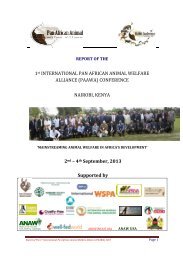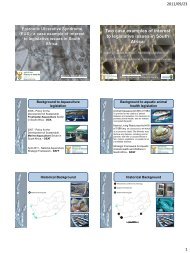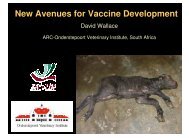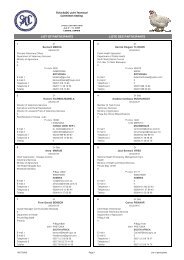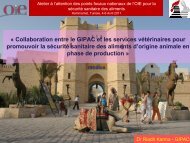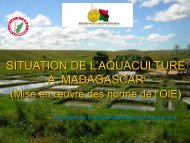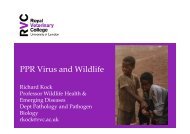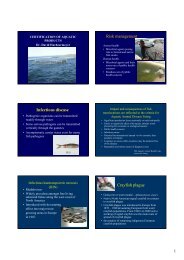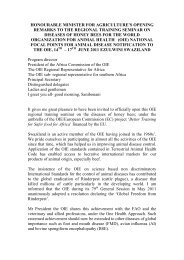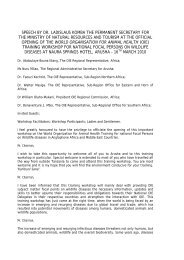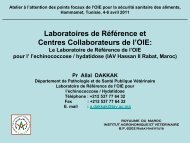Case Study: SPS Issues and Regional Trade in ... - OIE Africa
Case Study: SPS Issues and Regional Trade in ... - OIE Africa
Case Study: SPS Issues and Regional Trade in ... - OIE Africa
Create successful ePaper yourself
Turn your PDF publications into a flip-book with our unique Google optimized e-Paper software.
Critical <strong>in</strong> terms of compliance with the WTO <strong>SPS</strong> agreement is the full participation <strong>in</strong>submission of national animal pest <strong>and</strong> disease status <strong>in</strong>to the <strong>OIE</strong> WAHIS/WAHIDdatabases <strong>and</strong>, <strong>in</strong> fact, the general record of SADC is somewhat lackadaisical <strong>in</strong> thisregard. There have been several workshops held <strong>in</strong> SADC to ensure that membercountries report this <strong>in</strong>formation correctly – especially <strong>in</strong> terms of R<strong>in</strong>derpest <strong>and</strong> FMD.Another important program is the submission of requests for Provision of Veter<strong>in</strong>aryServices (PVS) Assessments <strong>in</strong> 13 out of 15 SADC Member States. The PVSassessment, which is a confidential document, aims at good governance of veter<strong>in</strong>aryservices, gap-analyses aimed at analyz<strong>in</strong>g the needs <strong>and</strong> resources to improve nationalveter<strong>in</strong>ary structures of SADC Member states.4.4 Provision for adaptation to regional conditions, <strong>in</strong>clud<strong>in</strong>g pest or disease freeareas <strong>and</strong> areas of low pest or disease prevalenceThe presence of FMD north of the control areas <strong>in</strong> Namibia, Botswana <strong>and</strong> South <strong>Africa</strong>effectively precludes trade <strong>in</strong> most animals 1 <strong>and</strong> many animal products both with<strong>in</strong> <strong>and</strong>from the FMD region. Given the fact that most countries <strong>and</strong> regions north of this l<strong>in</strong>e aretry<strong>in</strong>g <strong>in</strong> some way to control FMD, <strong>and</strong> the word<strong>in</strong>g of the current provisions of the TAHC,this is not likely to change <strong>in</strong> the foreseeable future.4.5 Do <strong>SPS</strong> measures meet <strong>in</strong>ternational transparency requirements?The requirement for transparency <strong>in</strong> <strong>SPS</strong> requirements is met <strong>in</strong> SADC countries throughtwo mechanisms. These are (1) the requirement for disease status submission of nationalanimal pest <strong>and</strong> disease status <strong>in</strong>to the <strong>OIE</strong> WAHIS/WAHID databases on a quarterlybasis <strong>and</strong> (2) trad<strong>in</strong>g partner <strong>in</strong>formation <strong>and</strong> assessments on a bilateral basis from, forexample, the United States Department of Agriculture - Animal <strong>and</strong> Plant Health InspectionService (USDA-APHIS) <strong>and</strong> United States Department of Agriculture – Food SafetyInspection Service (USDA-FSIS) <strong>and</strong> the EU European Food Safety Authority (EFSA).In terms of the pest <strong>and</strong> disease status of SADC countries, only parts of Namibia,Botswana, South <strong>Africa</strong> <strong>and</strong> Swazil<strong>and</strong> are recognized as be<strong>in</strong>g FMD disease free <strong>and</strong>thus able to export meat. However, the European Food Safety Authority (EFSA) has put <strong>in</strong>place additional requirements <strong>in</strong> terms of, for example, traceability, age of slaughteranimals, feed st<strong>and</strong>ards etc. <strong>in</strong> terms of BSE where EU requirements are somewhat higherthan those of the TAHC of the <strong>OIE</strong>. EFSA requirements have been disputed <strong>in</strong> the past byother countries such as the United States without success so the likelihood of SADCcountries challeng<strong>in</strong>g these is remote. However Namibia, Botswana <strong>and</strong> Swazil<strong>and</strong> havemanaged to comply with EFSA requirements. US requirements are somewhat moredifficult for SADC. Namibia is the only country that is currently work<strong>in</strong>g on market accessto the US with a series of visits from the USDA-FSIS. <strong>Issues</strong> be<strong>in</strong>g resolved ma<strong>in</strong>ly revolvearound the analysis of residue samples, particularly of growth hormones <strong>and</strong> veter<strong>in</strong>aryproducts. S<strong>in</strong>ce Namibia has been rely<strong>in</strong>g on South <strong>Africa</strong> for residue test<strong>in</strong>g <strong>in</strong> the past<strong>and</strong> s<strong>in</strong>ce South <strong>Africa</strong>n laboratories <strong>and</strong> test methods are not recognized by the US thisrequires Namibia to set up its own certified test<strong>in</strong>g facilities.WTO transparency <strong>and</strong> notifications by SADC countries are shown <strong>in</strong> Table 12. Only fivecountries <strong>in</strong> SADC have passed the basic WTO transparency test of hav<strong>in</strong>g set up a <strong>SPS</strong>enquiry po<strong>in</strong>t, a national notification authority <strong>and</strong> have sent <strong>SPS</strong> notifications to the WTO.However, only four SADC countries have submitted animal <strong>and</strong> meat product related1 Beef cattle, goats, sheep, <strong>and</strong> pigs23



